 For most of us, one of the biggest drains on our household budget is the cost of keeping winter’s chill out of our homes when the mercury dips. Drafty windows, dirty furnace filters and overheating your house can all contribute to higher energy bills.
For most of us, one of the biggest drains on our household budget is the cost of keeping winter’s chill out of our homes when the mercury dips. Drafty windows, dirty furnace filters and overheating your house can all contribute to higher energy bills.
Stay warm – and keep your energy bill under control – by adopting these 8 simple energy-saving tips:
—
Tip #1: Clean your furnace filter
Dirty filters reduce airflow. Increase your furnace’s efficiency by 50 percent by replacing or cleaning filters every two months. Permanent filters should be vacuumed or washed, then dried for 24 hours before being re-inserted.
Tip #2: Lower the thermostat (and wear a sweater!)
Save 2% on your heating bill for every 1 degree Celsius you lower thermostat. Install a programmable thermostat so you can automatically lower the heat 4 or 5 degrees when you’re away or asleep. That can add up to hundreds of dollars in savings each year.
Tip #3: Seal up drafts
Fix spots where cold wind is sneaking into your home. Caulking, insulating and installing weather stripping around drafty doors and windows is inexpensive and easy. A plastic window cover kit and a hair dryer takes care of leaky windows until you can replace them with double-pane windows. Or try thermal curtains to keep the house warm in the winter (and cool in the summer).
Tip #4: Reduce the hot water setting
To save energy, insulate your water tank and set the thermostat 2 degrees lower (between 60 and 65 degrees Celsius). This range is midway between “warm normal” or “low medium.
Tip #5: Do laundry efficiently
Do laundry in off-peak hours such as weekends and evenings. Wash with cold water if possible. Use high-speed spin settings to remove more water and reduce dryer time. Run loads of laundry back-to-back while the dryer is still warm. Clean the dryer’s lint trap before every load; a clogged filter can increase energy use by up to 30 percent.
Tip #6: Use energy-saving bulbs
Replace your home’s incandescent light bulbs with CFL or LED bulbs. The lower wattage takes less power (one 7-watt incandescent bulb could light 140 LED bulbs), plus you’ll save on cooling costs versus incandescent bulbs, which give off 90 percent of their energy as heat.
Tip #7: Adopt energy-efficient cooking
Only preheat your oven when baking. Keep the door shut as much as possible – up to 20 percent of the heat can escape when opened. When boiling water, keep power levels as low as possible once simmering to save electricity. Also, use smooth and flat-bottomed cookware, as they heat up more quickly.
Tip #8: Unplug electronics
Unplug electronics – especially phone chargers – when they aren’t in use. A single power bar can make it easier to turn many devices off at once. Lower your television’s brightness to use up to 25 percent less energy.
The energy-saving tips in this article have been adapted from the following websites. For more on this topic, visit:
OSPE has a partnership with The Personal Insurance Company with regards to home and auto insurance for our engineers, engineering graduates and engineering students.
To find out more, call 1-888-476-8737. Or visit thepersonal.com/https://ospe.on.ca/wp-content/uploads/2024/10/academy-banner-7.png.
Follow The Personal:
The Personal refers to The Personal General Insurance Inc. in Quebec and The Personal Insurance Company in all other provinces and territories of Canada.
The information and advice in this article is provided for informational purposes only. The Personal shall not be liable for any damages arising from any reliance upon such information or advice. The Personal recommends using caution and consulting an expert for comprehensive, expert advice.





Leave a Comment